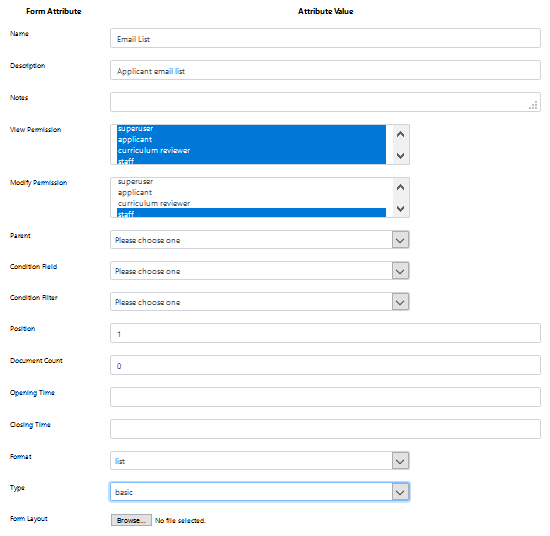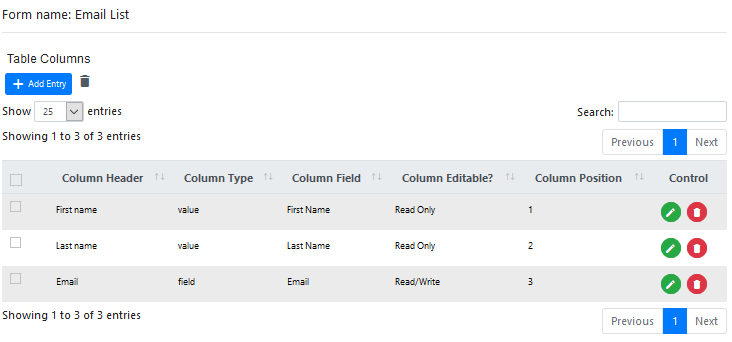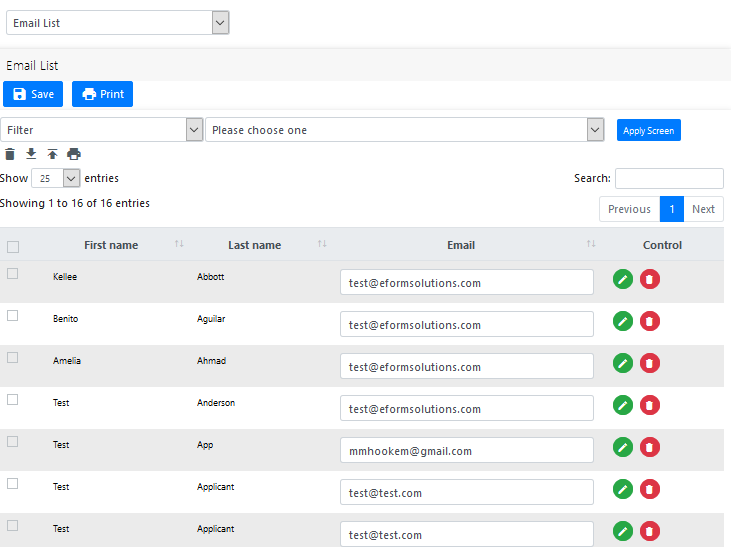Creating a Basic Form (list format)
A Basic Form can be created by accessing the Admin | Forms screen and clicking on the ![]() icon.
icon.
In this section we are going to create a form called "Email List" that uses a list format. Typically, a column will contain a title or header followed by values or entries and multiple columns can be defined.
STEP 1 - Enter General Form Information
As shown in Adding a Form, the following information must be specified before individual entries can be defined.
Name: "Email List"
Description: "Applicant email list"
View Permission: "superuser, Applicant, Curriculum Reviewer, Staff"
Modify Permission: "superuser, Staff"
Parent: None
Position: "1"
Document Count: "0"
Format: "list"
Type: "basic"
Once the general form information is entered, click on the ![]() icon to create the form.
icon to create the form.

STEP 2 - Define Form Entries
Once the Basic Form has been created, it will be added to the list of forms in the Admin | Forms screen. At this point, entries can be defined and added to the form.
To add entries, click on the ![]() icon in the Control column to edit the newly created form.
icon in the Control column to edit the newly created form.
The Edit Form screen will now show a section where columns can be defined.
To add a column, click on the ![]() icon and define the following information:
icon and define the following information:
![]() Header/Title - the entry name, displayed as the first column/row or, in the case of a title, as the row.
Header/Title - the entry name, displayed as the first column/row or, in the case of a title, as the row.
![]() Entry Type - value | field | filter score | html | hidden field | title only | contributor | conditional field | repeat start | repeat end | start columns | break columns | end columns
Entry Type - value | field | filter score | html | hidden field | title only | contributor | conditional field | repeat start | repeat end | start columns | break columns | end columns
![]() Value - the entry will display the value of Source Field.
Value - the entry will display the value of Source Field.
![]() Field - the entry will collect the value of Source Field.
Field - the entry will collect the value of Source Field.
![]() Filter score - the entry will display the score of Source Filter.
Filter score - the entry will display the score of Source Filter.
![]() Html - the Header/Title will simply be copied into the page without any format or filtering.
Html - the Header/Title will simply be copied into the page without any format or filtering.
![]() Hidden field - the entry will collect the value of a pre-defined field, but will hide what the user types.
Hidden field - the entry will collect the value of a pre-defined field, but will hide what the user types.
![]() Title only - the entry will display the Header/Title only.
Title only - the entry will display the Header/Title only.
![]() Contributor - the entry will collect the contributor's information (name and email)
Contributor - the entry will collect the contributor's information (name and email)
![]() Conditional field - the field will be displayed only if another field has a specific value
Conditional field - the field will be displayed only if another field has a specific value
![]() Multi-access field - the field can be accessed by multiple users.
Multi-access field - the field can be accessed by multiple users.
![]() Repeat start - used to display entries with multiple values (e.g. universities applied for)
Repeat start - used to display entries with multiple values (e.g. universities applied for)
![]() Repeat end - used to display entries with multiple values.
Repeat end - used to display entries with multiple values.
![]() Start columns - used to display entries in column fashion.
Start columns - used to display entries in column fashion.
![]() Break columns - used to handle a different column width.
Break columns - used to handle a different column width.
![]() End columns - used to display entries in column fashion.
End columns - used to display entries in column fashion.
![]() Save button - used to display the save icon button.
Save button - used to display the save icon button.
![]() Source Field / Source Filter - the name of the field or filter that will provide the value for the entry, if applicable.
Source Field / Source Filter - the name of the field or filter that will provide the value for the entry, if applicable.
![]() Repeat end - used to display entries with multiple values
Repeat end - used to display entries with multiple values
![]() Default Value - the default value for the entry, if any.
Default Value - the default value for the entry, if any.
![]() Edit Control - Read Only | Read/Write | Required | Read Only - Add.
Edit Control - Read Only | Read/Write | Required | Read Only - Add.
![]() Read Only - the entry can be viewed, but not modified.
Read Only - the entry can be viewed, but not modified.
![]() Read/Write - the entry can be viewed and modified.
Read/Write - the entry can be viewed and modified.
![]() Required - the entry is required to complete the form.
Required - the entry is required to complete the form.
![]() Read Only-Add - (only for entries of type Field) once a value is entered it cannot be changed, but new values can be added to the entry (e.g. Reviewer notes)
Read Only-Add - (only for entries of type Field) once a value is entered it cannot be changed, but new values can be added to the entry (e.g. Reviewer notes)
![]() Position - where the entry is located in the form.
Position - where the entry is located in the form.
![]() Display field info
Display field info
![]() Form Assistance - to define "fly over" text that will display over the entire column.
Form Assistance - to define "fly over" text that will display over the entire column.
The screen below shows the three entries that were created. Notice that the "first name" and "last name" entries have been defined as value type and the "email address" entry has been defined as a field type.

The screen below displays records using the "Email List" form just created. Notice that this form only allows changes to be made to the Email Address entry. The other two entries are displayed as values and therefore cannot be modified using this form.
